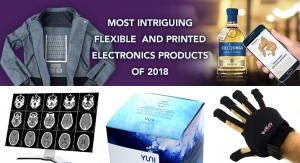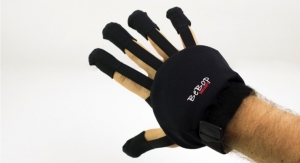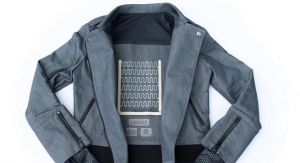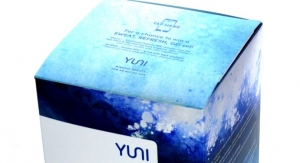David Savastano, Editor01.02.19
The winter months can get very chilly, and people heading outside are always trying to bundle up to shut out the cold and wind. Being able to generate heat within a jacket would be one way to help warm up.
With an eye on doing just that, Lubrizol asked Despina Papadopoulos of Principled Design in New York to create and develop the Multi-Tech Commuter (MTC) Jacket. Working with Butler Technologies and ACI Materials, Lubrizol and Papadopolous produced a fashionable denim jacket that uses flexible electronics to provide warmth on demand.
Mark Paczkowski, Ph.D. Technical Fellow, Corporate Technology and Externalization, The Lubrizol Corporation, noted that Lubrizol commissioned Principled Design to design and develop a garment showcasing various Lubrizol’s Engineered Polymers and Performance Coatings technologies to provide some of the missing links in wearable technology applications that can be combined to provide flexible performance and solutions. In doing so, Lubrizol proved that the technologies are available and that a team of partners could create a functional, stylish jacket quickly.
“The multifunctional jacket illustrates the building of a collaborative supply chain capable of implementing multiple functional technologies in a fashionable garment within a short period of time, “ Dr. Paczkowski said.
Dr. Paczkowski noted that each of the partners brought their own area of expertise to meet this challenge in nine months. Lubrizol brought its materials solutions and application expertise; Principled Design offered the design and development of the garment; ACI Materials contributed its expertise in conductive inks, encapsulants and flexible circuit heater technology design; and Butler Technologies added its skills in developing the printed electronics materials stack.
Meanwhile, the jacket had to be scalable, and the use of high precision screen printing of the conductive inks does just that. The result is a jacket that provides warmth while being comfortable, is fashion-forward rather than a novelty item, and can be manufactured on a large scale.
“The seamless integration of printed electronics provide a new kind of comfort and sensory feel that is unparalleled in other heated type garments,” said Dr. Paczkowski. “The jacket feels like an everyday jacket and is able to ‘transform’ without compromising any of its aesthetic and ‘wearable’ aspects.”
“We can now imagine and produce garments that can adapt to various environments and provide exceptional comfort, function and design at the same time, without the consumer having to focus on ‘gadget wear,” Papadopoulos said. “We are instead introducing an everyday garment that is truly ‘smart’, ‘adaptive’ and transformative. As far as we know, this is the first heating application on denim, making the jacket the ultimate urban-wear, taking you from a warm day to the cool evening without sacrificing comfort or style.”
There isn’t a lot of demand for a jacket that has wires protruding out of it or feels bulked up from the circuitry. One key to the Multi-Tech Commuter Jacket is that the flexible electronics are as unobtrusive as possible. The resistance of the conductive ink was tailored to the geometry of the heater and the voltage of the battery pack to provide a specific amperage. This, in turn, raises the temperature of the heating elements to the design target.
“We are using a ‘stack’ of materials, that are largely invisible to the user, except of course the printed conductive inks,” Dr. Paczkowski noted. “It is this stack and how it interacts with the fabric that makes the jacket soft, flexible and has a very pleasant ‘sensory’ feel. The interaction and compatibility of Lubrizol’s flexible TPU substrate with ACI conductive ink, encapsulant and adhesive are responsible for the jacket’s enhanced stretchability, for a look that feels truly part of the fabric. In this sense, we were able to produce a ‘heated’ fabric that feels truly part of the native properties of the material.”
Keeping the feel of an ordinary jacket was the biggest challenge the partners had to overcome.
“In addition to showcasing our technology, we wanted the MTC jacket to be stylish, comfortable and easy to maintain, so working with the right partners was key,” Papadopolous said. “The main obstacle was to indeed produce a thin and almost invisible technology, and we were able to accomplish this by approaching the whole jacket as a system, from concept to manufacturing. Each partner in the collaboration contributed to a clear, shared vision and committed resources to drive the program’s speed, problem-solving and successful outcomes.”
“We are in conversations with a number of clothing companies that are looking to integrate flexible printed electronics into various applications,” Dr. Paczkowski concluded. “We hope to see the underlying technologies and process demonstrated in the MTC jacket in the market soon. The whole goal of the project was to prove that these technologies, when carefully designed and considered, and with the right partner in place, can really go to scale.”
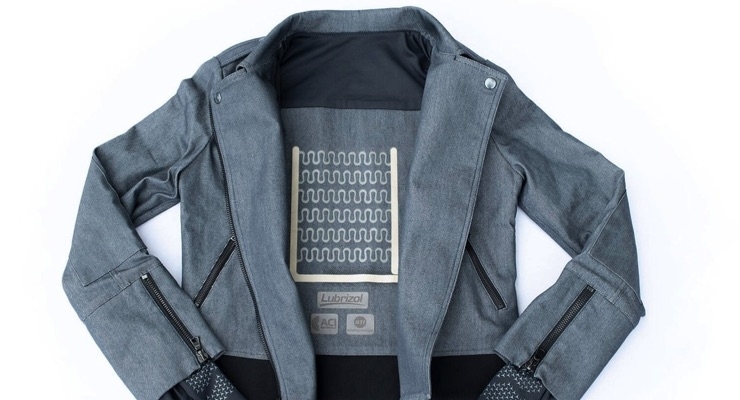
The Multi-Tech Commuter (MTC) Jacket. Source: Lubrizol.
With an eye on doing just that, Lubrizol asked Despina Papadopoulos of Principled Design in New York to create and develop the Multi-Tech Commuter (MTC) Jacket. Working with Butler Technologies and ACI Materials, Lubrizol and Papadopolous produced a fashionable denim jacket that uses flexible electronics to provide warmth on demand.
Mark Paczkowski, Ph.D. Technical Fellow, Corporate Technology and Externalization, The Lubrizol Corporation, noted that Lubrizol commissioned Principled Design to design and develop a garment showcasing various Lubrizol’s Engineered Polymers and Performance Coatings technologies to provide some of the missing links in wearable technology applications that can be combined to provide flexible performance and solutions. In doing so, Lubrizol proved that the technologies are available and that a team of partners could create a functional, stylish jacket quickly.
“The multifunctional jacket illustrates the building of a collaborative supply chain capable of implementing multiple functional technologies in a fashionable garment within a short period of time, “ Dr. Paczkowski said.
Dr. Paczkowski noted that each of the partners brought their own area of expertise to meet this challenge in nine months. Lubrizol brought its materials solutions and application expertise; Principled Design offered the design and development of the garment; ACI Materials contributed its expertise in conductive inks, encapsulants and flexible circuit heater technology design; and Butler Technologies added its skills in developing the printed electronics materials stack.
Meanwhile, the jacket had to be scalable, and the use of high precision screen printing of the conductive inks does just that. The result is a jacket that provides warmth while being comfortable, is fashion-forward rather than a novelty item, and can be manufactured on a large scale.
“The seamless integration of printed electronics provide a new kind of comfort and sensory feel that is unparalleled in other heated type garments,” said Dr. Paczkowski. “The jacket feels like an everyday jacket and is able to ‘transform’ without compromising any of its aesthetic and ‘wearable’ aspects.”
“We can now imagine and produce garments that can adapt to various environments and provide exceptional comfort, function and design at the same time, without the consumer having to focus on ‘gadget wear,” Papadopoulos said. “We are instead introducing an everyday garment that is truly ‘smart’, ‘adaptive’ and transformative. As far as we know, this is the first heating application on denim, making the jacket the ultimate urban-wear, taking you from a warm day to the cool evening without sacrificing comfort or style.”
There isn’t a lot of demand for a jacket that has wires protruding out of it or feels bulked up from the circuitry. One key to the Multi-Tech Commuter Jacket is that the flexible electronics are as unobtrusive as possible. The resistance of the conductive ink was tailored to the geometry of the heater and the voltage of the battery pack to provide a specific amperage. This, in turn, raises the temperature of the heating elements to the design target.
“We are using a ‘stack’ of materials, that are largely invisible to the user, except of course the printed conductive inks,” Dr. Paczkowski noted. “It is this stack and how it interacts with the fabric that makes the jacket soft, flexible and has a very pleasant ‘sensory’ feel. The interaction and compatibility of Lubrizol’s flexible TPU substrate with ACI conductive ink, encapsulant and adhesive are responsible for the jacket’s enhanced stretchability, for a look that feels truly part of the fabric. In this sense, we were able to produce a ‘heated’ fabric that feels truly part of the native properties of the material.”
Keeping the feel of an ordinary jacket was the biggest challenge the partners had to overcome.
“In addition to showcasing our technology, we wanted the MTC jacket to be stylish, comfortable and easy to maintain, so working with the right partners was key,” Papadopolous said. “The main obstacle was to indeed produce a thin and almost invisible technology, and we were able to accomplish this by approaching the whole jacket as a system, from concept to manufacturing. Each partner in the collaboration contributed to a clear, shared vision and committed resources to drive the program’s speed, problem-solving and successful outcomes.”
“We are in conversations with a number of clothing companies that are looking to integrate flexible printed electronics into various applications,” Dr. Paczkowski concluded. “We hope to see the underlying technologies and process demonstrated in the MTC jacket in the market soon. The whole goal of the project was to prove that these technologies, when carefully designed and considered, and with the right partner in place, can really go to scale.”

The Multi-Tech Commuter (MTC) Jacket. Source: Lubrizol.

